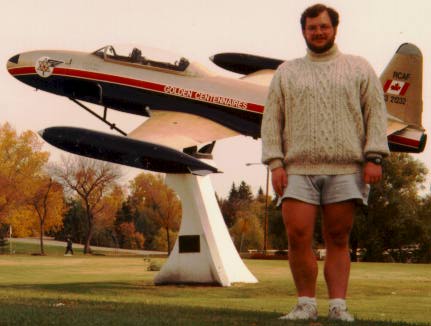
Updated: 1996/12/22 Sun

CT-133 AKA CL-30 Me and my T-33. The T-33 is a trainer used to introduce pilots to jet powered flight. The one in this picture is painted in the colours of the city of Winnipeg, blue and gold. The Golden Centennaires were an aerobatic team in honour of Winnipeg's Centennial, 1967.
STATS:
Crew: 2 (instructor, pupil) Service: 1952 to present (CAF) Max Speed: 495kt (917kph) @4,000' Cruise Speed: 165kt (306kph) Max Altitude: 47,000' Climb: 30,000' in 8:00 minutes Armaments: 2 x .50 Browning machine guns

CL-13 The CL-13 Sabre is identical in appearance to a standard F-86, however it's been upgraded with an improved Canadian Orenda engine for better performance. The Sabre was introduced during the Korean War when UN jets were found to be outclassed by the Russian MiG 15 Fagot.
STATS:
Crew: 1 (pilot) Service: 1951-1969 (CAF)
Max Speed: 526kt (975kph) @sea Max Range: 1,346nm (2,494km)
Cruise Speed: 425kt (787kph) @45,000' Max Altitude: 54,000' (16.46km)
Climb: 9,700 ft/min
Armaments: 6 x .50 Browning machine guns (300 rnd/gun)
2,000lb (907kg) on 2 hardpoints
Assorted bombs and rockets
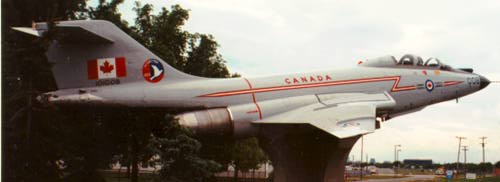
CF-101 The Voodoo is a long range interceptor that Canada used in conjunction with the United States to protect the northern territories.
STATS:
Crew: 2 (pilot/RIO) Service: 1961 to 80's (CAF)
Max Speed: 879kt (1,629kph, Mach 1.53) @36,000'
Cruise Speed: 518kt (958kph) @36,000' Max Altitude: 55,000' (16.80km)
Max Range: 1,845nm (3,420km)
Climb: 45,000 ft/min
Armaments: 4 x 20mm M39 cannon (375 rnd/gun)
4,000lb (1,814kg) on 5 hardpoints
various missiles and bombs, including sea mines and nukes

CF-104 aka CL-90 and CF-111 The Starfighter gained the nickname Widowmaker due to the large number of crashes the CAF experienced. Most of these were due to using the CF-104, an extremely fast, high altitude interceptor, for low-level flying. A CF-104 pilot holds the world's recognized altitude record.
STATS:
Crew: 1 (pilot) Service: 1950s to 80s (CAF)
Max Speed: 1,262kt (2,338kph, Mach 2.20) @36,000'
Cruise Speed: 530kt (981kph) @36,000' Max Altitude: 58,000' (17.68km)
Max Range: 1,845nm (3,420km) Combat Radius: 648nm (1,200km)
Climb: 55,000 ft/min
Armaments: 1 x 20mm M61A1 cannon (750 rounds)
2 x AIM-9 missiles on the wingtips (can switch with fuel)
4,310lb (1,955kg) on 7 hardpoints
various rockets, bombs, missiles, fuel under the wings
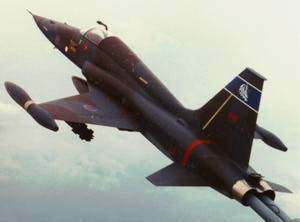
CF-5 The Freedom Fighter is a very utilitarion airframe with upgrades prolonging it's service. Bristol Aerospace here in Winnipeg is improving the avionics and wings of current F-5's to allow them to remain in service into the next century. Although not cutting edge they're still a capable aircraft. The training version, the T-38 Talon, is still in use today by many airforces around the world.
STATS:
Crew: 1 (pilot) Service: 1960s to present
Max Speed: 848kt (1,572kph, Mach 1.48) @36,000'
Cruise Speed: 556kt (1,030kph) @36,000' Max Altitude: 50,500' (15.39km)
Max Range: 1,400nm (2,594km) Combat Radius: 485nm (989km)
Climb: 33,000 ft/min
Armaments: 2 x 20mm M39E cannon (280 rnd/gun)
2 x AIM-9 missiles on the wingtips (can switch with fuel)
4,400lb (1,996kg) on 7 hardpoints
various rockets, bombs, missiles, fuel and gun pods

A-10 With a 30mm cannon in the nose, a titanium bathtub for pilot protection and more armour and armaments than a small tank this view of the Warthog is one you do not want to be looking at. The airframe is built around the Avenger cannon, a truly fearsome weapon with a single round of ammunition the size of an old glass soda-pop bottle. When fired the gun is capable of momentarily halting the aircraft in flight. The depleted uranium bullet shreds most tank armour as if it were cardboard. During the Gulf War two A-10 pilots were able to virtually annihilate an entire Iraqi tank convoy in less than an hour.
STATS:
Crew: 1 (pilot) Service: 1976 to present (USA)
Max Speed: 381kt (706kph) @sea level
Cruise Speed: 336kt (623kph) @sea level
Max Range: 2,131nm (3,949km) Combat Radius: 540nm (1,000km)
Climb: 6,000 ft/min
Armaments: 1 x 30 mm GAU-8/A Avenger cannon (1,350 rnd)
14,340lb (6,505kg) on 11 hardpoints
various ASM, bombs, CBU, LGB, rockets and gunpods
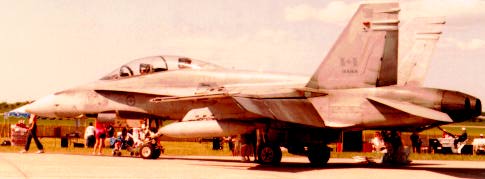
CF-188 The Hornet was Canada's next generation of advanced jet fighters. Although the loser to the F-16 in the American's Light Weight Fighter programme in the seventies, the original airframe (the YF-17) had many virtues and was developed further into the F-18. A sturdy ship, the Hornet isn't capable of winning a sustained dogfight against the Falcon. However due to it's unique configuration the plane is able to achieve higher alpha, or angle of attack, for short periods of time. Essentially this means you can bring your weapons to bear on an opposing aircraft even if they're a better turning aircraft. If you can rate your nose on the bandit and shoot, the flaming wreckage will no longer cause you any turning problems. Canadian Hornets are the only ones I've seen that have a shadow canopy painted on their underside, a scheme designed to confuse their opponent who at first glance would be unable to tell which way the fighter was turning.
STATS: (CF-18B)
Crew: 2 (pilot/RIO, B block) Service: 1980 to present (CAF)
Max Speed: 1,033kt (1,915kph, Mach 1.80) @high alt
Max Altitude: 50,000'+ (15.25km+)
Max Range: 1,800nm (3,336km) Combat Radius: 575nm (1,065km)
Climb: 45,000ft/min
Armaments: 1 x 20mm M61A1 Vulcan cannon (570 rnd)
2 x AIM-9 missiles on the wingtips (standard)
15,500lb (7,031kg) on 9 hardpoints
various AAM, ASM, anti-ship missiles, bombs, LGB, CBU, rockets

CT-114 Canada's famous aerobatic team, the Snowbirds, use the Tutor in their aerial displays. The Tutor isn't really a spectacular aircraft by any stretch of the imagination. However it does represent a solid, steady training platform to introduce pilots to jet powered aircraft. That the Snowbirds are capable of using it in their displays speaks not only to the high calibre of their training but to the versatility of this relatively old airframe.
STATS:
Crew: 2 (instructor/pupil) Service: 1963 to present (CAF)
Max Speed: 432kt (801kph) @28,500' (8.69km)
Max Altitude: 43,000' (13.11km)
Max Range: 541nm (1,002km)
Armaments: 2,000lb (907kg) on 2 hardpoints
assorted bombs, rockets, gun pods
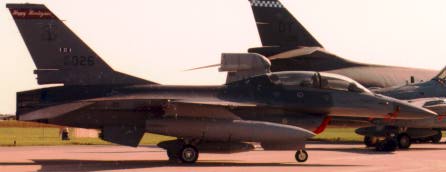
F-16 The Falcon was designed at the start of a new era. Big, powerful combat jets such as the F-14 Tomcat and F-15 Eagle were reaching increasingly higher price tags. The USAF required a new fighter that could handle a variety of taskings with a reasonable price tag. Two planes were evaluated, the General Dynamics YF-16 and the Northrop YF-17. The YF-16 was the winner and is considered one of the top production dogfighters of this era. Employing advanced avionics such as a fly-by-wire joystick and computer processing, the pilot is able to devote more time to completing the mission than to just keeping the plane in the air. The Falcon has demonstrated it's capability as a multi-role aircraft by not only being an exceptional dogfighter but also being capable of delivering munitions to target as shown in the Gulf War.
STATS: (F-16D)
Crew: 2 (pilot/RIO) Service: 1976 to present (USAF)
Max Speed: 1,146kt (2,124kph, Mach 2.0) @40,000' (12.19km)
Max Altitude: 50,000'+ (15.24km+)
Max Range: 2,100nm (3,891km) Combat Radius: 740nm (1,371km)
Climb: 50,000ft/min
Armaments: 1 x 20mm M61A1 Vulcan cannon (511 rnd)
2 x AIM-9 missiles on the wingtips (standard)
20,450lb (9,276kg) on 9 hardpoints (at reduced g loading)
AAM, ASM, anti-ship missiles, bombs, LGB, CBU, rockets, gun pod

P-51D The Mustang was one of the most famous American fighter aircraft of WWII. Ordered by the British it was the first propellor aircraft designed with a mind to reduce drag. With a laminar flow wing and specially designed air scoop the airframe has potential for high speeds. It wasn't until it was mated with the British Merlin engine that the Mustang truly shined. Despite using the same powerplant and being much heavier than it's British contemporary, the Spitfire, it was considerably swifter and for a period of time became the fastest prop plane in the war. With the addition of drop tanks it was able to escort American bombers on their daylight raids deep into Germnay. After the war it was still kept in service by many nations despite the move into the jet era. Modern air races see modified Mustangs achieving speeds in the area of 600 mph!
STATS: (P-51D)
Crew: 1 (pilot) Service: 1947-1952? (Canada)
Max Speed: 387kt (712kph) @24,000'
Max Range: 1800nm (3330km) Max Altitude: 40,000' (12.2km)
Climb: 20,000' in 6:30 minutes
Armaments: 6 x .50 Browning mg (400/270 rnd/gun inner pair/outer quartet)
1000lb (kg) on 2 hardpoints
assorted bombs and rocket projectiles
